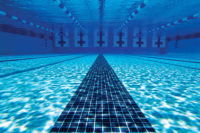Waterborne, two-component acrylic-epoxy coatings have become increasingly popular in the areas of high-performance architectural and light industrial maintenance. These coatings offer improved performance properties compared to typical waterborne acrylic emulsion-based coatings commonly used for these applications. Waterborne two-component acrylic-epoxy coatings offer the benefits of improved durability, improved resistance to food stains, household and industrial cleaners, low odor, and low VOC content. These coatings also offer the applicator the ideal properties of long pot life (typically more than 24 hours), fast dry times and easy clean up with soap and water. These versatile coatings are suitable for use on many common substrates, such as drywall, concrete block, galvanized steel, ferrous metals, masonry, plaster, stucco and wood.
The ideal application areas for these paints include many institutions and facilities such as: schools and universities, churches, hospitals, extended care facilities and department stores.
In most architectural applications the appearance of the coating is of utmost importance. The coating must be able to withstand frequent, and often vigorous, cleaning by the institutions’ maintenance staff, reducing the need to repaint. Therefore, durability and resistance to marring, stains and cleaning solutions and good aesthetics is critical.
Current Technology
Today, the majority of waterborne two-component acrylic-epoxy coatings are formulated using a carboxyl-functional acrylic latex resin with a waterborne “1-type” solid epoxy resin emulsion as the binder. It is also possible to use standard liquid epoxy resin emulsions in combination with the acrylic resin. Coatings that use liquid epoxy resins typically have high gloss and shorter pot life.The epoxy and acrylic resin react, albeit slowly, to provide the coating with the aforementioned properties. The ultimate properties of acrylic-epoxy coatings are reached over a period of 2-4 weeks of cure under ambient conditions.

A New Solid Epoxy Resin Emulsion

The paint formulations were adjusted to have the same acrylic:epoxy ratio, mixing ratio and solids content to facilitate the performance comparison.

Formulated Paint Testing
The formulated paints were tested to determine their performance properties using standardized test methods appropriate for the intended application.Testing Protocol
An induction time of 1 hour at 23 °C was given to both systems, which were then applied onto cold rolled steel panels (Q-Panel® S-48 SAE 1008/1010 panels; 0.032 in., ground finish) with a 5-mil drawdown bar. The paint films were cured at 23 °C and 50% relative humidity for 7 days before testing, unless otherwise specified. The test protocol used to evaluate the performance of the coatings is listed in Table 3.

The results of the testing are shown in Table 4. The acrylic-epoxy paint based on Araldite® PZ 3921 performed similarly to the coating based on the standard emulsion in most areas including dry times, gloss, adhesion, flexibility and abrasion resistance. However, the Araldite® PZ 3921-based paint did show significant improvements over the paint formulated with the standard emulsion in some key areas.
An important and substantial improvement was found in the scrub resistance. The Araldite® PZ 3921 system exceeded the performance of the control by nearly 2,600 cycles (79% increase) in scrub resistance testing showing the paints’ outstanding durability. A large improvement in impact resistance was also observed. Such an increase is very important for application on items fabricated from thin metal substrates, such as office furniture. The excellent inter-coat adhesion of the Araldite® PZ 3921 coating allows the applicator to apply up to several coats of the paint in an eight-hour period, resulting in increased productivity. The coating based on the standard emulsion does seem to have a longer recoat window, however.

Conclusion
Waterborne, two-component acrylic-epoxy coatings offer better performance properties than acrylic latex paints, lending to their use as high-performance architectural and light industrial coatings. Among the benefits of these paints are better durability, abrasion resistance, stain and chemical resistance, and water resistance.A new epoxy resin emulsion Araldite® PZ 3921 was developed to improve the performance of these paints, specifically by making them even more durable. The Araldite® PZ 3921 emulsion increased the scrub resistance by 2,600 cycles, a 79% increase over the standard emulsion used for these applications. This feature provides longer lasting and, thus, more economical paints for use in high traffic areas that require frequent cleaning.
The paints based on Araldite® PZ 3921 also proved to be more impact resistant, a favorable feature for light-duty coatings for metal, such as those for office furniture. In the face of tightening VOC limits, Araldite® PZ 3921 also offers the potential for lower VOC content coatings due to its lower solvent content compared to the standard epoxy emulsion.
For more information, visit www.huntsman.com.
All information contained herein is provided "as is" without any warranties, express or implied, and under no circumstances shall the authors or Huntsman be liable for any damages of any nature whatsoever resulting from the use or reliance upon such information. Nothing contained in this publication should be construed as a license under any intellectual property right of any entity, or as a suggestion, recommendation or authorization to take any action that would infringe any patent. The term "Huntsman" is used herein for convenience only, and refers to Huntsman Corporation, its direct and indirect affiliates, and their employees, officers, and directors.


Report Abusive Comment